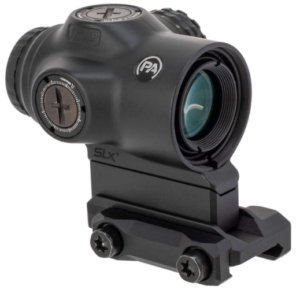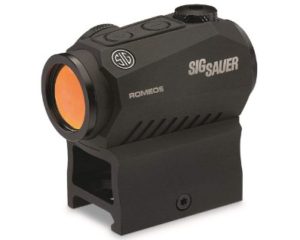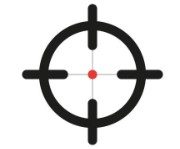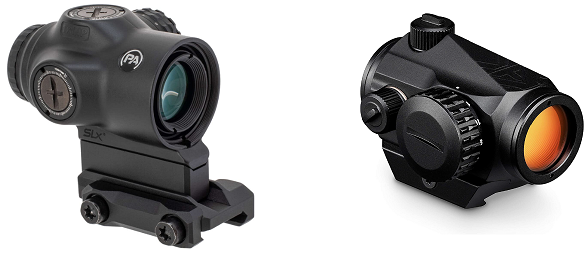If you own many firearms, you have to be familiar with the different types of sights available. This is important as it will help you improve your shooting experience. Optical sights help you to aim better and improve precision and accuracy at varying distances.
Gone are the days of solely relying on iron sights. This is because the shooting world has embraced the evolution of red dots and other cutting-edge hybrid optics like prism sights for firearms.
Prism sights and red dots have unique advantages that help to improve precision and accuracy. Therefore, it is important to understand the major differences between the two sights. This will help you determine which optic is the best for your shooting application.
The major difference is that prism sights magnify the reticle’s image with a reflective prism. This offers a traditional sight picture compared to red dots. On the other hand, red dots use LED technology to project the reticle onto a lens to improve precision and accuracy. They are more intuitive, making them suitable for beginners.
In this post, we will take a closer look at each sight’s important features, pros, and cons. This will help you to make an informed decision and hone your precision and accuracy skills.
Let us get right into it.
What is a Prism Sight?
 A prism sight is an optic that magnifies the reticle’s image using a reflective prism. They are designed to provide a clear and precise aiming point. This helps to eliminate any guesswork in your shooting.
A prism sight is an optic that magnifies the reticle’s image using a reflective prism. They are designed to provide a clear and precise aiming point. This helps to eliminate any guesswork in your shooting.
Prism sights are popular because they offer a compact and versatile solution for engaging close-range targets. They have a 1x magnification, but you can buy a prism scope with a higher magnification. However, they do not offer the best variable magnification compared to traditional scopes.
It is worth mentioning that the reticle is etched into the prism. This exceptional feature ensures that the reticle remains focused on the target regardless of the distance from your eyes. This makes it easy to acquire short to medium ranges.
The other exceptional feature of prismatic scopes is the lightweight design. Manufacturers can easily update and add new features, unlike traditional scopes. However, prism scopes are heavier than most red dots available today.
Prism sights are suitable for shooters with astigmatism. They also have good eye relief, ideal for shooting applications requiring situational awareness.
Prism sights also come with coated lenses to improve clarity. The coatings also protect the exterior lenses from dust and other particles.
Let us look at the pros and cons.
Pros
- Prism sights are available in different reticles to accommodate various shooting applications.
- They are available in different magnification levels.
- They feature coated lenses to improve clarity and keep off dirt and grime.
- They are illuminated, allowing you to use them in different lighting conditions.
- They are excellent for shooters with astigmatism.
- They have a lightweight design.
Cons
- They do not provide a parallax-free experience.
- They do not have unlimited eye relief.
- It takes time to learn how to use them effectively.
What is a Red Dot Sight?
 A red dot is a close-range optic that projects a red dot onto a reflective lens to help you acquire targets easily. They are used to acquire targets under 100 yards or less.
A red dot is a close-range optic that projects a red dot onto a reflective lens to help you acquire targets easily. They are used to acquire targets under 100 yards or less.
Red dots are popular because they are very easy to use. This makes them ideal for beginners who want to hone their precision and accuracy skills.
Red dot sights’ exceptional feature is unlimited eye relief. Therefore, you can use both eyes when aiming at a target. The red LED dot stays aligned, allowing you to acquire targets easily.
When buying a red dot, it is important to consider the MOA (Minutes Of Angle). This is the size of the dot and the distance covered. We recommend red dot sights with a larger MOA for close-range targets. Smaller MOA red dots are ideal for engaging medium to long-range targets.
Investing in a high-end red dot with premium-quality lenses is advisable to improve clarity. You must ensure that the lenses are coated to improve image quality.
In addition, you must check the durability of the red dot sight. The sight you buy should be made from durable materials that withstand recoil and impact. This is because there are many cheap knock-offs available today.
Let us look at the pros and cons
Pros
- They have a wide field of view, which helps to improve accuracy.
- They are made from durable materials and have a shock-resistant and waterproof design.
- They are compatible with many firearms.
- They have a compact and low-profile design.
- They are more affordable compared to high-end scopes.
Cons
- Red dots are battery dependent.
- They are not suitable for long-range shooting.
- They are less durable that prism scopes.
Frequently Asked Questions on Prism Vs Red Dot
- Do red dot sights have night vision?
Yes, some red dot sights have night vision capabilities, but not all of them. Night vision compatible red dot sights are designed to work with night vision devices and provide a visible reticle in low-light conditions. However, they can be more expensive compared to regular red dot sights. It’s important to check the specifications of a red dot sight before purchasing to determine if it has night vision capabilities.
- What is the main difference between a prism sight and a red dot sight?
A prism sight uses a reflective prism to magnify the reticle’s image. This provides a clear and precise sight picture. A red dot sight projects the reticle onto a lens using LED technology to provide a quick and intuitive aiming solution.
- Do prism sights have a wider field of view than red dot sights?
Prism sights offer a wider field of view compared to red dot sights. This makes them suitable for shooting applications where situational awareness is required. However, they do not have unlimited eye relief.
- Which is better for short-range shooting, a prism sight or a red dot?
You can use prism sights and red dots for short-range shooting. However, red dots are quicker and more intuitive, making them a popular choice for close-quarters combat.
- What are the advantages of using a prism sight for hunting?
The advantages of using a prism sight for hunting include a wider field of view, a clear and precise sight picture, and the ability to make fine adjustments to the reticle. These features make prism sights ideal for hunting in various light conditions and at different ranges.
Conclusion
By now, we are sure you know the difference between a prism scope with 1x magnification and a red dot sight. As you have seen, they have unique features to improve precision and accuracy. This is why they are ideal for a wide range of shooting applications.
We recommend prism scopes for target shooting and hunting. This is because they provide a clear and precise sight picture.
Red dots are suitable for self-defense, hunting, or target practice. This is because they are quick, intuitive, and versatile.
However, the choice will depend on your shooting requirements. This is why it is important to define them before making any purchase.
We hope this post helped you learn more about prism and red dot sights. You can also check 7 Best Red Dots for 9mm Rifle

